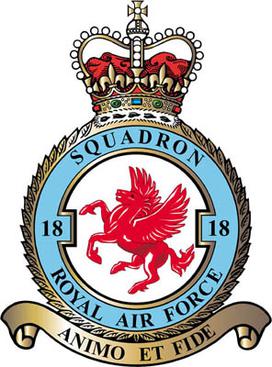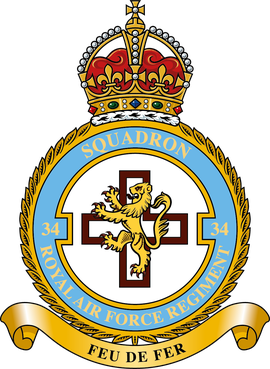
The Royal Air Force Regiment is part of the Royal Air Force and functions as a specialist corps. Founded by Royal Warrant in 1942, the Corps carries out soldiering tasks relating to the delivery of air power. Examples of such tasks are non-combatant evacuation operation (NEO), recovery of downed aircrew, and in-depth defence of airfields by way of aggressively patrolling and actively seeking out infiltrators in a large area surrounding airfields. In addition the RAF Regiment provides Joint Terminal Attack Controllers (JTACs) to the British Army in the Tactical Air Control Party (TACP) role, and provides flight size commitment to the Special Forces Support Group.

The Joint Chemical, Biological, Radiological and Nuclear Regiment was a specialist expeditionary unit of the British armed forces. Personnel of the Joint CBRN Regiment were trained in the detection, identification and monitoring of nuclear, biological and chemical weapons.

No. 18 Squadron of the Royal Air Force operates the Boeing Chinook from RAF Odiham. Owing to its heritage as a bomber squadron, it is also known as No. 18 (B) Squadron.

Number 31 Squadron, known as the Goldstars, is a squadron of the Royal Air Force. The Squadron lays claim to being the first military unit to fly in India, where it was based from 1915 to 1947. Throughout the Cold War, No. 31 Squadron was based in West Germany, flying from RAF Laarbruch and RAF Brüggen. Between September 1984 and March 2019, the Goldstars operated the Panavia Tornado GR1/4, initially from RAF Brüggen and after August 2001 from RAF Marham, Norfolk. No. 31 Squadron was disbanded on 14 March 2019 at RAF Marham and reformed on 11 October 2023 at RAF Waddington, Lincolnshire, equipped with the General Atomics Protector RG1.

Number 13 Squadron, also written as XIII Squadron, is a squadron of the Royal Air Force which operate the General Atomics MQ-9A Reaper unmanned aerial vehicle from RAF Waddington since reforming on 26 October 2012. The unit first formed as part of the Royal Flying Corps on 10 January 1915 and went on to fly the Martinsyde G.100, the Royal Aircraft Factory F.E.2, the SPAD VII and SPAD XIII, the Sopwith Dolphin during the First World War. In the Second World War it started out operating the Westland Lysander for army cooperation. From late 1942 it used Blenheims in North Africa but in 1943 squadron converted to Ventura for coastal patrols and convoy escort duties. Post war it operated Mosquito before transitioning to the new jet aircraft Gloster Meteor and English Electric Canberra for photoreconnaissance. From 1 January 1990, it operated the Panavia Tornado, initially the GR1A at RAF Honington and later the GR4/4A at RAF Marham where it temporarily disbanded on 13 May 2011.

Royal Air Force Germany, commonly known as RAF Germany, and abbreviated RAFG, is a former command of the Royal Air Force (RAF) and part of British Forces Germany (BFG). It consisted of units located in Germany, initially in what was known as West Germany as part of the British Air Forces of Occupation (BAFO) following the Second World War, and later as part of the RAF's commitment to the defence of Europe during the Cold War. The commander of RAFG doubled as commander of NATO's Second Allied Tactical Air Force (2ATAF). Its motto was 'Keepers of the Peace'.

No. 51 Squadron RAF Regiment is a field squadron of the RAF Regiment in the Royal Air Force. Its mission is protection of RAF bases from ground attack.

The Royal Auxiliary Air Force (RAuxAF), formerly the Auxiliary Air Force (AAF), together with the Air Force Reserve, is a component of His Majesty's Reserve Air Forces. It provides a primary reinforcement capability for the regular service, and consists of paid volunteers who give up some of their weekends, evenings and holidays to train at one of a number of squadrons around the United Kingdom. Its current mission is to provide trained personnel in support of the regular RAF.

The II Squadron RAF Regiment is a Field Squadron of the RAF Regiment based at RAF Brize Norton. Some of its gunners receive parachute training.

No. 504 Squadron was one of the Special Reserve Squadrons of the Auxiliary Air Force, and today is a reserve force of the RAF Regiment. It was integrated into the AAF proper in 1936. Based at RAF Cottesmore, Rutland, 504 Squadron used a variety of light bombers before being re-tasked to fighters with the Hawker Hurricane in 1939. It subsequently became a Fighter Squadron. Currently No. 504 Squadron no longer has a flying role, but as part of No 85 Expeditionary Logistics Wing of the RAF A4 Force.
No. 3 Squadron RAF Regiment was a field squadron of the RAF Regiment in the Royal Air Force. Its mission was protection of RAF bases from ground attack.

No. 15 Squadron RAF Regiment is a field squadron of the RAF Regiment in the Royal Air Force. Its mission is protection of RAF bases from ground attack. The squadron's headquarters is at RAF Marham, having moved from RAF Honington.

No. 27 Squadron RAF Regiment was a CBRN squadron of the RAF Regiment in the Royal Air Force with the Defensores Defendo. It disbanded in October 2021.

No. 34 Squadron RAF Regiment is a C-UAS Sqn of the RAF Regiment in the Royal Air Force. Its mission is to detect, track, and ultimately disrupt and destroy unmanned airborne vehicles. The squadron's current HQ is at RAF Leeming. The motto of the squadron is "Feu de Fer "(Fire from Iron).
No. 612 Squadron RAF was originally formed in 1937 as an Army Co-operation unit, and flew during the Second World War in the General Reconnaissance role. After the war the squadron was reformed and flew in the Day Fighter role until disbanded in 1957. At present the squadron has a non-flying role as a RAF Medical Reserves unit.
No. 2623 Squadron RAuxAF Regiment is a Royal Auxiliary Air Force RAF Regiment reserve squadron based at RAF Honington. It was formed on 1 July 1979 to provide ground defence of the station. Tasked with preventing Soviet Special Forces from disrupting flying operations, personnel were recruited from across East Anglia and formed an integral part of the station's war-fighting capability for the next 15 years. Throughout this period, the squadron participated in many exercises and held annual camps in the United Kingdom, Germany and Gibraltar, winning the Strickland Trophy competition in 1991.
Second Allied Tactical Air Force was a NATO military formation under Allied Air Forces Central Europe tasked with providing air support to NATO's Northern Army Group (NORTHAG). 2 ATAF commanded all flying units based within its sector and all reinforcements flying into its sector, as well as ground-based radar systems and stations, air defense units and the airfields in its sector.
No. 2503 Squadron RAuxAF Regiment is a Royal Auxiliary Air Force RAF Regiment reserve squadron based at RAF Waddington, in Lincolnshire, fairly close to the city of Lincoln and RAF Cranwell. Gunners are recruited both from ex-regulars in the RAF Regiment and civilians in a 50 miles radius surrounding RAF Waddington. The squadron is an infantry squadron in the dismounted close-combat force protection role. The squadron consists of two Flights of RAF Regiment personnel and one Flight of RAF Police personnel.
No. 37 Squadron RAF Regiment was a Ground Based Aircraft Defence (GBAD) squadron of the Royal Air Force Regiment. The squadron operated mostly outside the United Kingdom since its formation in 1951 until 2006 when it was disbanded. It started out as a field squadron before becoming involved in the GBAD programme, where it operated the Rapier missile system.
No. 16 Squadron RAF Regiment was a field squadron of the Royal Air Force Regiment. The squadron operated mostly outside the United Kingdom since its formation in 1948 until 2006 when it was disbanded. It started out as a field squadron before becoming involved in the GBAD programme, where it operated the Rapier missile system.














